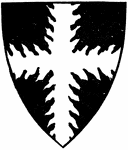
Potent Counter-Potent Shield
"Potent counter-potent, sometimes called varry cuppy, differs from potent in that the potents of the…

Frette Shield
"The Frette is composed of a Bendlet and Scarp and a Mascle interlacing each other."—Aveling,…

Flanch Shield
"The Flanch is formed of a segment of a circle placed on the side of the shield. It is always borne…

Rustre Shield
"The Rustre differs from the mascle in that the perforation of the device is circular and not throughout."—Aveling,…

Label Shield
"The Label is a Closet of Barrulet placed on the upper part of the field, and having three of more pendents…
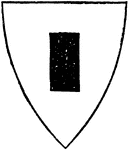
Billet Shield
"The Billet is a right-angled figure a little longer than broad, resembling a folded letter in form,…

Bordure of Border Shield
"The Bordure of Border surrounds the field, and generally covers one-fifth of the shield."—Aveling,…

Cross Voided
"A Cross voided is not unlike the Cross double parted, but the bars do not run through or across the…
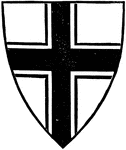
Frimbriated Cross
"The Fimbriated Cross is a cross having a border of another tincture, generally for the purpose of allowing…

Cross Quarterly
"Cross Quarterly is a Cross cut by a partition line, and the tinctures reversed or counter-changed."—Aveling,…

Four Fusils in Cross
"It will be observed that the charge upon the shield in this instance is not the Cross, but the lozenges."—Aveling,…

Cross Fleury
"A Cross Fleury, or Fleurie, is borne in the arms of Lord Brougham and Vaux. It is not very unlike the…
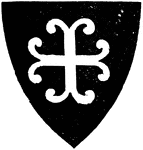
Cross Recercelée
"The Cross Recercelée is very similar to the Cross Moline, but the extremities are curled backwards."—Aveling,…
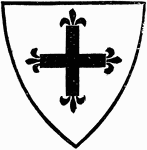
Cross Fleur-De-Lis
A heraldic shield with a charge cross in which the extremities terminate with fleurs-de-lis.

Paly Bendy
"Produced by lines drawn vertically, by others drawn diagonally, or by a compound of Paly and Bendy."—Aveling,…

Chequée
"Chequée is when the field is divided by lines perpendicular and horizontal, crossing each other,…

Counter-Componée
"Counter-componée has two rows of squares, with a metal and color alternating."—Aveling,…

Shield of Robert de Vere
The heraldic shield of Robert de Vere, close advisor of King Richard II of England.

Effigy of Henry, First Duke of Lancaster
An effigy of the first Duke of Lancaster in his coat of arms.

Jupon of Sir Edmund de Thorpe
"Jupon from the Effigy of Sir Edmund de Thorpe, Ashwel-Thorpe Church, Norfolk."—Aveling, 1891

Tabard
A common item of men's clothing during the Middle Ages. It is a short coat with short sleeves or shoulder…

Heraldic Shield with a Lion's Face
The shield of a knight of the time of Edward II. The lion's face is a common charge in heraldry.

Eagle
The heraldic charge of the eagle is one of the earliest charges. It holds the same rank that the lion…

Shield Semée
"When several charges appear in one shield, the number in each row is generally indicated - as, 'three,…

Anchor
"This charge is borne with a cable, and set fesse-wise, by the British Admiralty; but it is usual to…

Covered Cup
"An egg-shaped, ornamental, covered cup, with a circular pedestal and base."—Aveling, 1891

Fylot Shield
"A description of cross, with the ends or extremities bent at right angles."—Avelin, 1891

Panache
"A plume of feathers, generally those of the peacock, set upright, so as to form a crest. The Panache…

Pheon
"The barbed head of a spear or arrow, engrailed on the inner side. The point of the spear is placed…

Rose-en-Soleil
"The rose argent of the House of York, surrounded with rays, as of the sun."—Aveling, 1891

Shield of Jaspar Tudor
"Shield and supporters of Jaspar Tudor, K.G., Earl of Pembroke in 1452 and in 1485 Duke of Bedford;…

Shield of John de Hastings
"Shield of John de Hastings, K.G., Earl of Pembroke, Quatering De Hastings and De Valence, and impaling…

Shield of Queen Isabella
"Quartered shield of arms borne by Isabella, Queen of Edward II."—Aveling, 1891

Shield of Queen Philippa
The heraldic shield of Philippa of Hainault, the Queen consort of Edward III of England.


